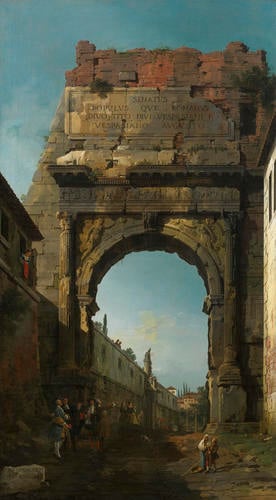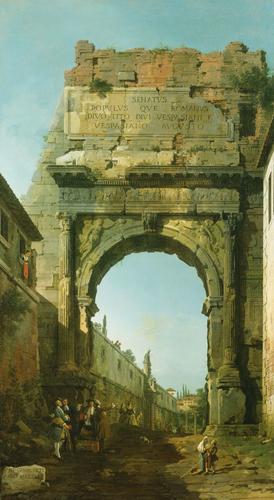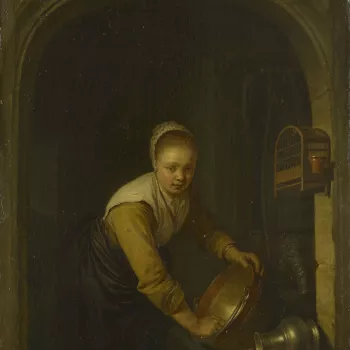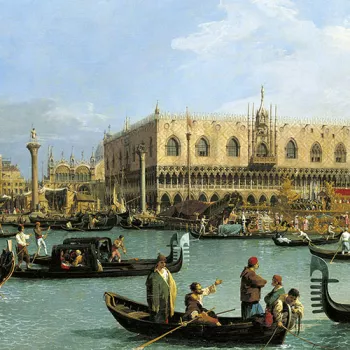The Arch of Titus Signed and dated 1742
Oil on canvas | 192.2 x 106.5 cm (support, canvas/panel/stretcher external) | RCIN 401002

Canaletto (Venice 1697-Venice 1768)
The Arch of Titus Signed and dated 1742


-
This painting is one of a unique group of five large upright views of Rome, depicting the major sights of the ancient city (RCIN 401002, RCIN 400700, RCIN 400713, RCIN 400524, RCIN 400714). Unusually for Canaletto, all the works are signed and dated prominently in the foreground. It is thought that the paintings formed a special commission for Canaletto's great friend and patron Joseph Smith, British Consul in Venice, who sold his outstanding group of paintings, prints and drawings to George III. Their tall narrow format suggests that the paintings were originally designed for a specific location, probably decorating a room within Smith's palace on the Grand Canal, however the cycle does not fall into an obvious arrangement. Acquired by George III in 1762, the paintings were hung in English frames in the Entrance Hall of Buckingham House, alongside the Venetian views.
This painting depicts the Arch of Titus, which stands at the south-eastern end of the Forum at the head of the Sacred Way. It is the oldest of the great Roman triumphal arches, and was erected in AD 81 to commemorate the capture of Jerusalem by the Emperor Titus. It is being admired by a group of three gentlemen 'Grand Tourists', with their abate or cicerone(guide). The wall of the sixteenth-century Farnese Gardens is visible through the arch on the left, and in the distance are the ruins of the temple of Castor and Pollux.
The works are of high competence, yet are not entirely typical of Canaletto. While Canaletto did visit Rome around 1720, it is unlikely that he made a return journey in the 1740s. Therefore, it is generally supposed that this painting, and the rest of the cycle, is based upon drawings made by Canaletto's nephew, Bernardo Bellotto (1720-1780), who entered his studio in the mid-1730s and had been in Rome during the relevant period. Indeed, the treatment of the figures, the tendency towards heavy shadows, and the less-convincing three-dimensionality of the pictures, are atypical of the style of Canaletto. It is certainly possible that Canaletto based his painting on Bellotto's oil sketch, although there are several discrepancies: for example, only the top half of the Castor and Pollux columns is visible in the sketch, because of the higher point of the arch, and the inscription is different.
While there are few pentimenti in Canaletto's Roman view series, here the second figure in the group on the left originally turned his face to his companion and the right arm of the third figure originally stretched out to the left.
Signed and dated: ANT. CANAL / ANNO MDCCXLII
Adapted from Canaletto & the Art of Venice, London, 2017.Provenance
Acquired in 1762 by George III from Joseph Smith, British Consul in Venice (Italian List no 56); recorded in the Hall at Buckingham Palace in 1790
-
Medium and techniques
Oil on canvas
Measurements
192.2 x 106.5 cm (support, canvas/panel/stretcher external)
221.7 x 132.0 x 15.0 cm (frame, external)
Category
Object type(s)









